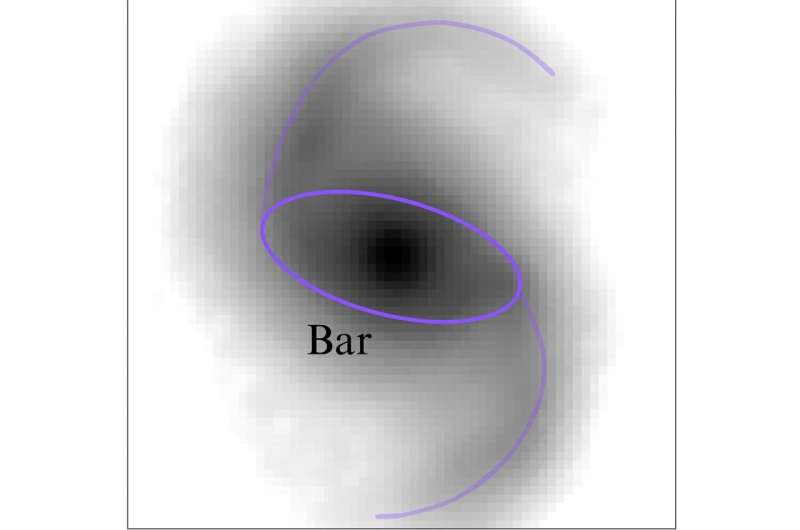
The universe’s early galaxies were less chaotic and developed much faster than previously thought, according to new research looking back more than ten billion years in time. An international team of astronomers led by Durham University, UK, has used the James Webb Space Telescope (JWST) to find evidence of bar formation when the universe was only a few billion years old.
This latest research is published in the journal Monthly Notices of the Royal Astronomical Society.
Bars are elongated strips of stars found in disk or spiral galaxies like our Milky Way. As bars develop, they regulate star formation within a galaxy, pushing gas into the galaxy’s central region, and their presence tells scientists that galaxies have entered a settled, mature phase.
Previous studies carried out using the Hubble Space Telescope had been able to detect bar forming galaxies up to eight or nine billion years ago. But the increased sensitivity and wavelength range offered by the JWST means researchers have been able to see the phenomenon happening even further back in time. This means that scientists might have to rethink their theories about galaxy evolution in the early stages of the universe’s formation.
Lead author Zoe Le Conte, a Ph.D. researcher in the Centre for Extragalactic Astronomy, Department of Physics, Durham University, said, “Galaxies in the early universe are maturing much faster than we thought. This is a real surprise because you would expect the universe at that stage to be very turbulent with lots of collisions between galaxies and a lot of gas that hasn’t yet transformed into stars.
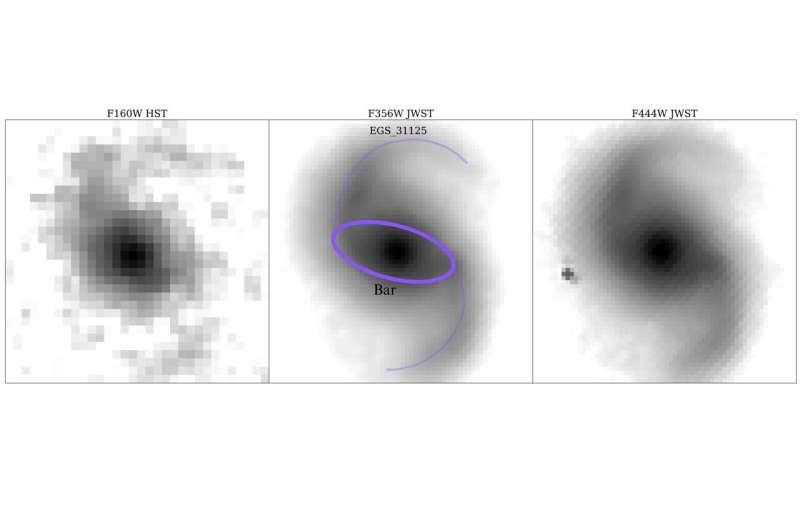
“However, thanks to the James Webb Space Telescope we are seeing a lot of these bars much earlier in the life of the universe which means that galaxies were at a more settled stage in their evolution than previously thought. This means we will have to adjust our views on early galaxy evolution.”
The researchers used the JWST to look for bar formation in galaxies as they would have been seen between eight to 11.5 billion years ago. The universe itself is 13.7 billion years old.
Of 368 disk galaxies observed, the researchers saw that almost 20% had bars—twice as many than observed by Hubble.
Co-author Dr. Dimitri Gadotti, in the Centre for Extragalactic Astronomy, Department of Physics, Durham University, noted, “We find that many more bars were present in the early universe than previously found in Hubble studies, implying that bar-driven galaxy evolution has been happening for much longer than previously thought. The fact that there are a lot more bars is what’s very exciting.
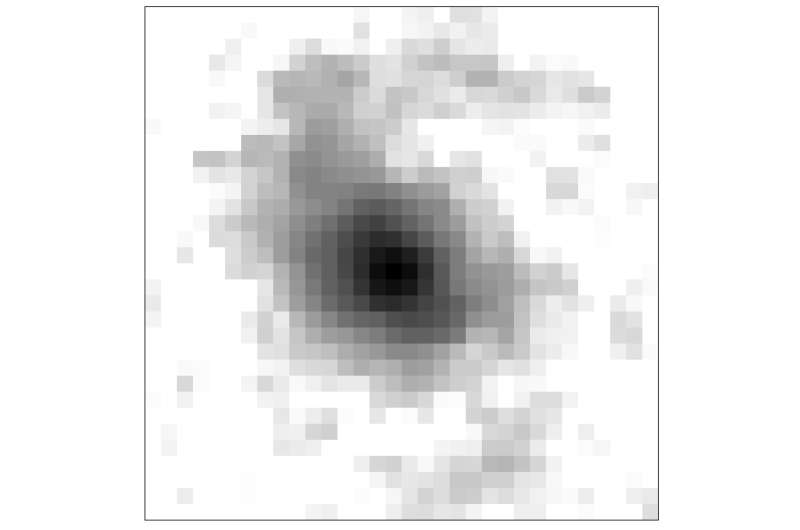
“The simulations of the universe now need to be scrutinized to see if we get the same results as the observations we’ve made with James Webb. We have to think outside of what we thought we knew.”
As the researchers looked further back in time, they were able to see fewer and fewer bar-forming galaxies.
They say this might be because galaxies at an even earlier stage of the universe might not be as well formed. There is also currently no way to see shorter bars of stars, which are less easy to spot, even with the increased telescopic power offered by the JWST.
The researchers say they now want to investigate even more galaxies in the early universe to see if they have also formed bars. They hope to eventually look further back in time—12.2 billion years—to look at bar-growth over time and what the mechanisms are behind this growth.
-
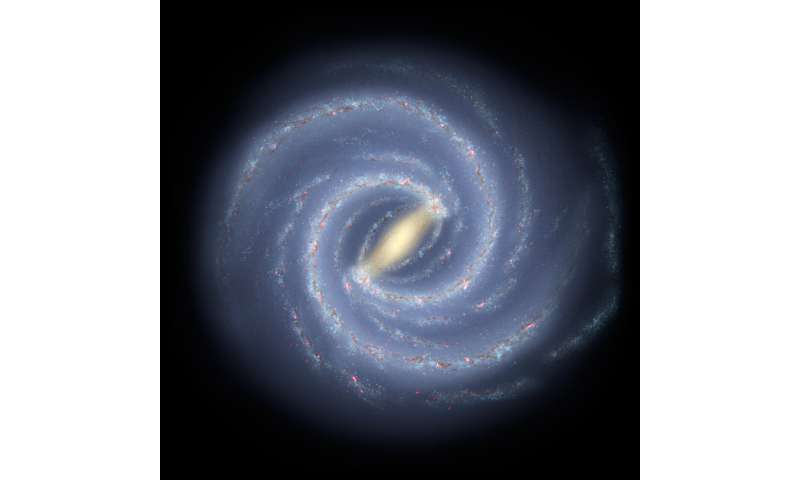
Artist’s impression showing the structure of the Milky Way. The bar is the yellowish elongated structure crossing the center of the galaxy. Credit: NASA/JPL-Caltech/ESO/R. Hurt
-
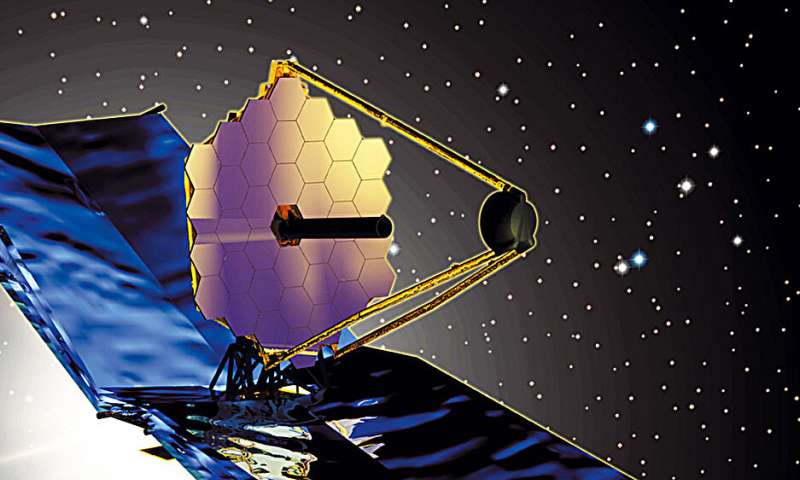
Artist’s impression of the James Webb Space Telescope showing its primary mirror pointing into the cosmos. Credit: TRW-Ball
The JWST is the replacement for the Hubble Space Telescope and is the largest, most powerful space telescope ever built.
Durham University’s Centre for Extragalactic Astronomy was involved in the telescope’s scientific development, including the Mid-Infrared Instrument (MIRI), which is used to probe galaxies and black holes. Durham’s Centre for Advanced Instrumentation also made some of the optics for the JWST’s Near Infrared Spectrograph’s (NIRSpec) Integral Field Unit instrument.
The latest study also included scientists from Durham University’s Institute for Computational Cosmology, University of Victoria, Canada; Jodrell Bank Centre for Astrophysics—University of Manchester, UK; the European Southern Observatory; the Department of Astronomy and Atmospheric Sciences, Kyungpook National University, Republic of Korea; the Max Planck Institute for Astronomy, Germany; Aix Marseille University, France.
More information:
Zoe Le Conte et al, A JWST investigation into the bar fraction at redshifts 1 < z < 3, Monthly Notices of the Royal Astronomical Society (2024). DOI: 10.1093/mnras/stae921. On arXiv: DOI: 10.48550/arxiv.2309.10038
Citation:
Star bars show universe’s early galaxies evolved much faster than previously thought (2024, April 23)
retrieved 23 April 2024
from https://phys.org/news/2024-04-star-bars-universe-early-galaxies.html
This document is subject to copyright. Apart from any fair dealing for the purpose of private study or research, no
part may be reproduced without the written permission. The content is provided for information purposes only.







